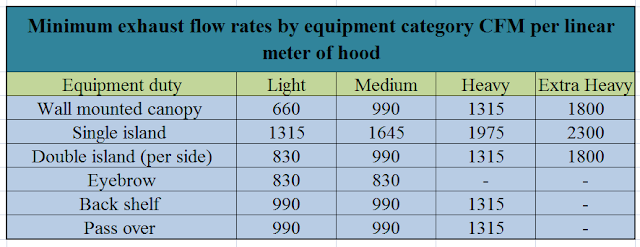Kitchen-Hood Ventilation Designing
Kitchen-Hood Ventilation Designing
Buildings with Kitchens
1. Hotels
2. Restaurants
3. Hospitals
4. Canteens
5. Retail Malls
6. Residences
7. Jails etc.
Basic purpose of kitchen ventilation
- To provide a comfortable environment in the kitchen.
- to ensure the safety of the people working in the kitchen and other building occupants by:
- Effective removal of effluents which may include gaseous, liquid and solid contaminants produced by the cooking process and products of fuel and food combustion.
- Effluents con be life threatening and flammable
Types of Hoods
1. Wall type hood
2. Island type hood
P= L+2W for wall type hood
P= 2L+2W for Island type hood
KITCHEN HOOD SYSTEM
An exhaust hood
- The centre piece of any kitchen ventilation system (KVS)
- Not just a sheet metal box but a critical component is a well engineered system
- Much greater awareness today about the need for an effective KVS
- Issues are health, safety, efficiency and energy savings
Exhaust Hoods
- Type 1 - for removing grease & smoke : used for cooking appliances
- Type 2 - for steam, vapour, heat & odour when grease is not present : used for diswashers, steam tables etc.
Basic styles of type 1 hood
- Wall mounted canopy
- Single island
- Double island
- Back shelf or proximity
- Pass over
- Eyebrow
Hood Styles
Wall canopy hood
- Cooking appliance placed against a wall
- Minimum air flow requirement
- 3" builts in gap between hood & wall
- Three finished sides
- Less susceptible to cross drafts
- Minimum overhang requirement : 6" on sides and 6" - 12" in front for full captue
Single island hood
- Cooking appliance/s (row) placed in the middle ( not against all )
- Four finished sides
- More susceptible to cross drafts
- Recommended overhang : 12" on all 4 sides
- Baffle filters in "V" configuration
Double island hood
- Double row of appliances placed back to back
- two wall canopy hoods placed back to back
- Recommended overhang : 12" on all 4 sides
Basic styes of type 2 hoods
- Oven hood
- Condensate hoods
Type 2 hood - Condensate hood
- Removal of hesat, odour and omisture
- Condensate baffle and gutter to condense moist air and drain the water
- Used over diswashers
Exhaust flow rate
- Calculation of proper exhaust flow rate is very critical for effective operation oa a KVS
- The upward velocity o fthe effluent thermal currents is mainly a function of the temperature of the cooking surface and varies from 16FPM over steam equipment to 160 FPM over charcoal Broilers.
- Appliances categorized in 4 groups by cooking duty
Appliance duty category
- For a combination of appliances in a row under a single hood, the flow rate is based on the heaviest duty appliance unless the hood design permits different rates over different secions of the hood.
CFM = 150xP for Medium cooking
CFM = 100xP for Light cooking
CFM = 100xP for Light cooking
- Exhaust/makeup air 1500-2200 /fpm duct velocity
- Duct to be terminated 40" above the roof
- Cleanouts to be provided at the base of riser and every 20 feer
- Duct sheet metal gauge
2. 18ga. 304 S.S
- Hood construction 18ga. minimum
- Black steel duct is used all kitchen ducts (Hood) S.Steel duct is used for laundry exhaust.
- Stainless steel
304 for this type is used for hood
316 & 318L for special & pure stainless steel for operation theater in hospitals.
















No comments